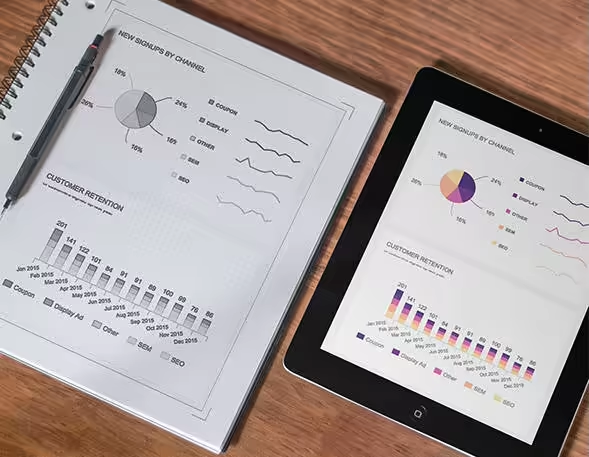A business report is an orderly summary of company interests created following research. The purpose of the business report is to provide relevant stakeholders with important information. It must be prepared using the proper structure to accomplish this efficiently. A business report is therefore produced in a certain format to organize information so the reader can easily grasp it. In addition to other information about business reporting formats, we have highlighted the top 8 components of a business report in this post.
Business reporting formats
A business report's information flow can be structured. A straightforward corporate presentation design places the conclusions and suggestions ahead of the introduction and findings. This is used in the corporate world since audiences are "time-poor".
In order to ensure that business reports fulfill their purpose effectively, incorporating strategies from different sectors can be beneficial. One such compelling approach is embarking on a finance transformation journey within Financial Planning & Analysis (FP&A). This effort not only enhances data accuracy in reports but fosters better integration and communication across departments. For example, when initiating finance transformation, companies should develop robust collaboration strategies with HR and IT departments to align overall goals while utilizing agile methodologies for continuous improvement.
Headings help directly organize your report. Consider adding sub-headings beneath your primary heading if a particular section contains several parts. To ensure that the links are obvious and that the font size, style, underlining, and capitalization are all used consistently, make sure that this is done logically.
You can either use headlines that serve a purpose or ones that are more descriptive and include material. Headings should be concise, relevant, and consistent. Instead of using the headers to introduce your text, you should repeat some or all of the information in each heading in the first phrase that follows it.
Related: What Matters In the HR Board Report
Arrangement of a Report
The Front Matter, the Body of the Report, and the Back Matter make up the three sections of a business report. The information that precedes the report's real content is referred to as the front matter. The letter of transmittal, title page, executive summary, table of contents, and illustration make up the front matter. The title page and table of contents are essential, but the other components might not be.
Transmittal Letter (Cover letter)
A transmittal letter is one of the components of the business report format. Transmittal letters, as they are often known, are not a component of the report, but they accompany it to specify its subject and provide a brief explanation. Additionally, it briefly summarizes the preview conclusions and lists the major points of the business report. It says who ordered the report and expresses gratitude for everyone who worked on it. This letter, annexed to the top of the report, is composed politely. They are sometimes referred to as cover letters because the letter of transmittal doubles as a standard cover page.
Title Page
The first page of a business report is the title page. The following are included in it:
- The subject's heading
- Name of the write
- recipient's name, title, and organization
- Report purpose
- The submission date
A business report's title should make it obvious what kind of report it is and point out its purpose. Both the lettering and alignment should be in capital letters. Depending on a corporation's requirements, the title page's formatting may change. The topic, scope, and aim should be reflected in the title. It should include "annual report" or "feasibility" in the title or subtitle. In the heading, the title should not be abbreviated. Include your organization's name, the person receiving the report, the authors', investigators', and compilers' names and positions, dates, and the period the report covers. After you have written the title page, the executive summary will be next.
Executive Summary
A business report's executive summary is a short overview section. It serves as a short explanation of the report's purpose and its main conclusions, recommendations, or results. This report section largely concentrates on its major themes and relevant information. It may also comprise the company's immediate strategic goals or long-term corporate ambitions. The highest-ranking employees in the organization are alerted to the most crucial
KPIs through a quick summary of all the most crucial measures in the report, which they will take into account when making decisions. There are typically four components to an executive summary in business reports:
1. Start with the problem or need the document is solving
Explain why this document and the project it represents are important at the beginning of your executive summary. Spend some time outlining the issue, taking into account any research or customers. Explain why and in what ways this issue is significant to your clients.
2. Outline the recommended solution
After outlining the issue, provide your proposed solution. In contrast to an abstract, your solution should be prescriptive, and you should attempt to persuade your readers that it is the best one. This section serves more as a place to support your suggested solution rather than as a place for brainstorming. It's acceptable if you don't have all of your deliverables and milestones planned out because you're drafting your executive summary at the beginning of your project. However, this is your time to briefly outline the project's course of events. Consider generating a before getting started on your executive summary if you need assistance putting together a high-level overview of the key objectives and schedule for your project.
3. What value does the solution have?
You now go into greater depth about how your solution will affect and enhance the issue you initially stated. You concentrate mostly on what is expected. Any pertinent financial information, project hazards, or prospective advantages should be included in this area. By outlining how the current project aligns with your corporate aim, you should also connect this project to your company ambitions.
4. Wrap up with a conclusion about the importance of the work
This is your final opportunity to help executive stakeholders comprehend the significance and impact of this effort on the business after you've given them all the relevant facts. You highlight the main points readers of the executive summary can learn from in conclusion.
Related: The Complete Guide to Fax Cover Sheets: Enhancing Professional Communication
Table of contents
The reader can locate the various sections of the report using a table of contents. It appears on a different page. Each section's page number and any appendices connected to the report are included. It excludes the executive summary, abstract, and title page.
Figures List/Illustration
The titles and locations of the visuals (figures, drawings, pictures, and maps) in a report are identified in the list of figures. Figures focus information in novel ways and display crucial configurations, details, and supporting data.
Body of the Report
The sections between the introduction and conclusion are referred to as the body of the report, which is its major text.
The body of your report contains a detailed explanation of your work. The report's main body explains what was done, how it was done, what the outcomes were, and what inferences and suggestions might be made in light of those results. There are three major sections in the report's body.
- Introduction
- Findings and Documentation
- Conclusion and Recommendation
Introduction
The project's challenge should be clearly stated in the introduction, along with the important reasons. If one is available, it ought to reflect the circumstance. For the reader to comprehend the issue's importance, background information must also be provided in the report introduction. The process used to arrive at the solution should be briefly summarized.
Findings and Documentation
The findings and the documentation section are part of the business report that provides a detailed context for understanding the research output. The research documentation should give readers a general understanding of the information acquired, what it represents, the types of information and data files to expect, and how to tie that information to the study's findings. The amount of information or directions that would allow a reader to approach several research questions using the same data are not necessary for research documentation because it is not a comprehensive reference. There will be a lot more textual storytelling than forma data sets. By using headers, subheadings, and numbered sections to arrange everything, the results can be made easier to read. You can use a table or bullet points to present your findings. You might also use infographics and other visuals to explain your findings, but ensure these graphics are acceptable for the report.
Related: Reporting Performance a Step by Step Guide for Business Leaders
Conclusion and Recommendation
In a business reporting format, the last part of the body is the conclusions and recommendations section. The conclusion allows the author to examine and summarize the key concepts discussed in the report whilst the recommendations suggest actions to be performed in response to the findings in the business report. Therefore, you summarize your analysis based on the data in this area and offer suggestions for further action. If you include any objectives, make sure they have measurable actions. Each objective, strategy, or choice should explain to the reader how it will impact the company.
Back Matter
Appendices, references, and glossary are all included in the back matter, which is the final component of a business report. References are used whenever you use information from other sources. There are different styles of referencing, and your organization may stipulate these. Important information that might not readily fit in the report's body can also be found in the back matter. The appendix section is reserved for important material referenced in your report. However, appendices may also include supplementary material that enhances understanding for the reader and provides details on the process or analysis you underwent. The objective of each item was described when it was first mentioned in the report's body. Thus, there is no need to elaborate on or link the various elements in the back matter. These more in-depth materials, essential to supporting the report, are thus simply located in the back matter.
Whilst other parts of a business report may appear to be more important than others, they all are significant to the different stakeholders in an organization. It is therefore important to write the entire report with as much attention to bringing out the purpose of every part.



